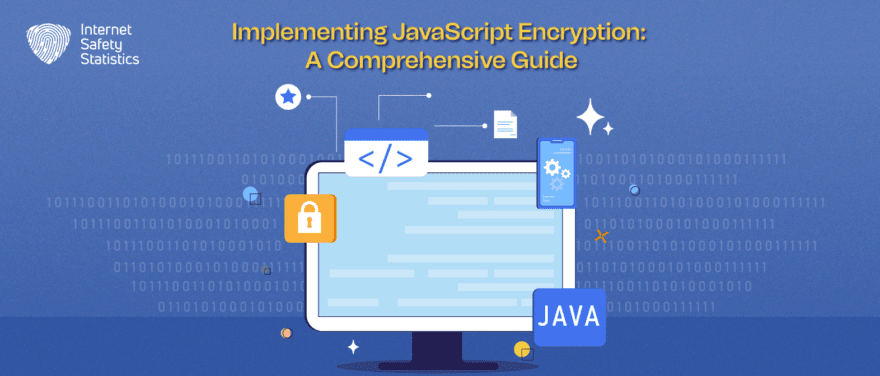
JavaScript encryption, also known as client-side encryption, involves encrypting data directly within a web browser using JavaScript code. This approach offers several advantages over server-side encryption, including enhanced user privacy, improved performance, and reduced reliance on server resources.
What is JavaScript Encryption?
JavaScript Encryption is the process of converting plain text data into an unreadable format using mathematical algorithms and protecting it from unauthorised access and modification. It is a crucial security mechanism for web applications, enabling developers to safeguard sensitive information such as user credentials, financial data, and personal information.
JavaScript offers various libraries and tools for implementing encryption, enabling developers to choose the appropriate algorithm and key management approach for their specific needs. Popular libraries include CryptoJS, Node.js built-in crypto module, and AJAX Crypto.
Benefits of JavaScript Encryption
- Enhanced User Privacy: JavaScript encryption enables encryption to occur on the client side, keeping sensitive data out of the hands of external servers or intermediaries. This protects user privacy and reduces the risk of data breaches.
- Improved Performance: Encrypting data on the client side can significantly improve performance, especially for real-time applications. Since data decryption and encryption tasks are handled locally, there is no need to send data back and forth between the client and server, reducing network traffic and latency.
- Reduced Server Load: JavaScript encryption offloads encryption and decryption tasks from the server, minimising the server’s workload. This can free up server resources for other critical operations, improving server responsiveness and overall system performance.
Challenges of JavaScript Encryption
- Browser Compatibility: Implementing JavaScript encryption across different browsers can be challenging due to browser inconsistencies and compatibility issues. Developers need to ensure that encryption algorithms and functions work consistently across various browser platforms.
- Cross-Site Scripting (XSS) Vulnerabilities: JavaScript encryption can be vulnerable to XSS attacks if not implemented correctly. Malicious scripts injected into a web page could potentially compromise the encryption process, rendering it ineffective.
- Limited Control: JavaScript encryption is executed on the client side, giving the user more control over the encryption process. This can lead to situations where users may disable or tamper with encryption mechanisms, potentially compromising data security.
Implementing Encryption in JavaScript
JavaScript provides built-in cryptographic capabilities, enabling developers to encrypt and decrypt data on the client side. This can be useful for enhancing data security in web applications, such as securing user input, protecting data stored in local storage, or ensuring the confidentiality of data transmitted between the client and server.
Choosing an Appropriate Encryption Library
Several encryption libraries are available for JavaScript, each with its strengths and features. Popular choices include:
- CryptoJS: A mature and widely used library that supports a wide range of encryption algorithms, including AES, DES, and RSA.
- Node.js built-in crypto module: A comprehensive crypto library that offers various cryptographic primitives, including encryption, hashing, and random number generation.
- AJAX Crypto: A lightweight and easy-to-use library that provides simplified encryption functions for common use cases.
The choice of encryption library depends on the specific needs and requirements of the application. For example, CryptoJS is a suitable choice for web development, while Node.js crypto module is better suited for server-side applications. AJAX Crypto is a good option for simple encryption tasks.
Generating Secret Keys and Key Pairs
Secret keys and key pairs are essential for encryption and decryption. Secret keys are used for symmetric-key encryption, where the same key is used for both encryption and decryption. Key pairs are used for asymmetric-key encryption, where one key (public key) is publicly shared, and the other (private key) is kept confidential.
Secret keys and key pairs can be generated using various methods, such as the CryptoJS.enc.Utf8.parse() function for generating a secret key from a string and the crypto.subtle.generateKeyPair() function for generating an RSA key pair.
Preparing Data for Encryption and Decryption

Before encrypting or decrypting data, it needs to be prepared in a format that is compatible with the chosen encryption algorithm. This may involve encoding the data using appropriate encoding schemes, such as Base64 encoding, or padding it to ensure a consistent length.
For example, to encrypt a string using AES, the data would first be encoded using Base64 encoding. Similarly, to decrypt an encrypted ciphertext using RSA, the ciphertext would first need to be converted back from Base64 encoding.
Performing Encryption and Decryption Operations
Once the secret key or key pair is generated and the data is prepared, encryption and decryption operations can be performed using the chosen encryption library.
For symmetric-key encryption, the CryptoJS.AES.encrypt() function is used to encrypt the data using the secret key, while the CryptoJS.AES.decrypt() function is used to decrypt the ciphertext using the same secret key.
For asymmetric-key encryption, the crypto.subtle.encrypt() function is used to encrypt the data using the public key, while the crypto.subtle.decrypt() function is used to decrypt the ciphertext using the private key.
Additional Considerations
When implementing encryption in JavaScript, it is important to consider the following:
- Security: Choose strong algorithms and keys, avoid weak key generation practices, and protect keys from unauthorised access.
- Performance: Choose the appropriate encryption algorithm for the application’s requirements.
- Compatibility: Ensure that the chosen encryption library is compatible with all browsers and devices that the application will run on.
- Testing: Thoroughly test the encryption code to ensure that it is working correctly and that sensitive data is being protected.
- Documentation: Document the encryption implementation, including the chosen algorithms, key sizes, and key generation methods.
Demonstrating Encryption Methods
JavaScript provides various encryption libraries that simplify the process of cryptographic operations. Popular choices include CryptoJS, Node.js built-in crypto module, and AJAX Crypto.
AES Encryption using CryptoJS Library
JavaScript
import CryptoJS from 'crypto-js';
const data = 'This is the data to be encrypted.';
const key = CryptoJS.enc.Utf8.parse('This is the secret key.');
const encrypted = CryptoJS.AES.encrypt(data, key);
const decrypted = CryptoJS.AES.decrypt(encrypted, key);
console.log('Original Data:', data);
console.log('Encrypted Data:', encrypted.toString());
console.log('Decrypted Data:', decrypted.toString());RSA Encryption using Node.js Built-in Crypto Module
JavaScript
const crypto = require('crypto');
const message = 'This is the message to be encrypted.';
const publicKey = 'MIGfMA0GCSqGSIb3DQEBAQUAA4GNADCBiQKBgQCRn/04a0y/x57hR48k5n7/1nXe26f5aS+zY/D230gFb0c744+v5f5l5iPtA8j+p953b4f9vL+1X8e6/n/23+P93/8/v/7vD+yX9X+b/7X+3/9/5/2/6/1/33/y/7/9/9/7/9/9/7/7/9/5/7/5/9/9/9/9/9/5/7/9/3/8/3/7/3/7/4/3/7/2/8/3/7/3/7/3/7/9/5/9/9/5/9/9/3/3/7/3/7/3/7/3/7/3/7/9/4/7/3/7/3/7/3/7/7/9/9/9/9/9/9/7/9/3/9/7/7/9/9/9/9/7/7/9/4/7/3/7/3/7/3/7/3/7/7/9/9/9/9/9';
const encryptedData = crypto.subtle.encrypt('RSA-OAEP', publicKey, new TextEncoder().encode(message));
const decryptedData = crypto.subtle.decrypt('RSA-OAEP', privateKey, new TextDecoder().decode(encryptedData));
console.log('Original Message:', message);
console.log('Encrypted Data:', encryptedData.toString());
console.log('Decrypted Data:', decryptedData.toString());AJAX Crypto Library for Simplified Encryption Operations
JavaScript
const AJAXCrypto = require('ajax-crypto');
const encryptedData = AJAXCrypto.encrypt('AES-256', 'This is the secret key.', 'This is the data to be encrypted.');
const decryptedData = AJAXCrypto.decrypt('AES-256', 'This is the secret key.', encryptedData);
console.log('Original Data:', 'This is the data to be encrypted.');
console.log('Encrypted Data:', encryptedData);
console.log('Decrypted Data:', decryptedData);Real-World Applications of JavaScript Encryption
JavaScript encryption plays a crucial role in enhancing data security in web applications. It is employed in a variety of scenarios to safeguard sensitive information from unauthorised access. Here are some of the key areas where JavaScript encryption finds real-world applications:
Securing User Input and Data Storage
- Form Validation: JavaScript encryption can be used to protect sensitive user input data entered into forms, such as credit card numbers or personal information. Encrypting this data before being submitted to the server makes it unreadable to potential eavesdroppers or malicious code.
- Local Storage Encryption: JavaScript encryption can be used to encrypt data stored locally in the browser’s localStorage or sessionStorage. This ensures that sensitive information stored in the browser is protected from unauthorised access, even if the browser is compromised.
- Password Storage: JavaScript encryption can be used to securely store user passwords locally in the browser or on the server side. Encrypting passwords using secure algorithms prevents them from being exposed in plain text in case of data breaches or security vulnerabilities.
Protecting Data Transmitted between Client and Server
- HTTPS/TLS Encryption: HTTPS is the standard protocol for secure communication over the Internet. It utilises encryption algorithms, including AES and RSA, to safeguard data transmitted between the client and server, protecting it from interception and eavesdropping. JavaScript plays a role in enabling HTTPS connections and ensuring that data is encrypted and decrypted appropriately.
- Client-side Data Encryption: JavaScript encryption can also be used to encrypt data before sending it to the server. This can be useful for sensitive data that may be vulnerable during transmission, such as payment information or user authentication tokens.
Implementing Secure Communication Protocols
- WebSockets Encryption: WebSockets are a communication protocol that enables real-time data exchange between the client and server. JavaScript encryption can be used to secure WebSocket connections, protecting sensitive data transmitted between the two parties.
- P2P Communication Encryption: JavaScript encryption can also be employed for secure peer-to-peer communication, where users directly exchange data without the need for a central server. This can be used for file sharing, voice chat, or other applications that require private communication.
These examples demonstrate the versatility of JavaScript encryption in safeguarding sensitive data throughout the web application lifecycle, from user input to data transmission and storage. By incorporating encryption into web applications, developers can significantly enhance data security and protect user privacy.
Security Considerations and Best Practices for JavaScript Encryption

Implementing encryption in JavaScript applications requires careful consideration of security principles and best practices to ensure the integrity and confidentiality of sensitive data. Here are some key aspects to prioritise:
1. Choose Strong Algorithms and Keys
Select robust and well-established cryptographic algorithms, such as AES (Advanced Encryption Standard) and RSA (Rivest-Shamir-Adleman). These algorithms have undergone rigorous security analysis and are considered secure against known attacks.
Use sufficiently long key lengths for the chosen algorithms. Longer keys provide better protection against brute-force attacks, making it computationally infeasible to break the encryption. For symmetric-key encryption, use keys of at least 256 bits in length. For asymmetric-key encryption, use keys of at least 3072 bits in length.
2. Avoid Weak Key Generation Practices
Avoid generating keys using insecure methods, such as insecure random number generators. Employ secure random number generators provided by the operating system or cryptographic libraries to ensure the randomness and unpredictability of key values.
Avoid reusing keys for different encryption operations. Each key should be used exclusively for a specific purpose to prevent the compromise of multiple data sets if one key is compromised.
3. Protect Keys from Unauthorised Access
Never store keys in plain text. Instead, securely store keys using appropriate cryptographic mechanisms, such as hardware secure modules (HSMs) or password-protected key stores.
Restrict access to key generation and storage processes to authorised personnel only. Implement access control measures and auditing mechanisms to monitor key usage and prevent unauthorised access or modifications.
4. Handle Errors and Exceptions Gracefully
Implement robust error handling and exception handling mechanisms to prevent potential security breaches in case of unexpected errors or unexpected input.
Validate user input data and gracefully handle invalid data to prevent potential attacks that could exploit weaknesses in the encryption process.
5. Regularly Update Encryption Libraries
Keep encryption libraries up to date with the latest security patches and improvements. Libraries may encounter vulnerabilities that could be exploited to break encryption.
Regularly review and update encryption implementations to ensure they align with the latest security best practices and address any newly discovered vulnerabilities.
Testing and Debugging Encryption Code
Thorough testing and debugging are crucial for ensuring the security and reliability of encryption implementations in JavaScript applications. Here are some key aspects to consider for effective testing and debugging:
1. Utilising Browser Developer Tools for Debugging
Leverage browser developer tools to step through encryption code, inspect variables, and debug potential issues. Tools like Chrome DevTools and Firefox Web Developer provide powerful debugging capabilities, allowing developers to identify and resolve problems in the encryption process.
2. Writing Unit Tests and Integration Tests
Implement unit tests to verify the correctness of individual encryption functions, ensuring they perform as expected and produce the intended output for different input data. Integration tests should encompass the entire encryption workflow, including key generation, encryption, decryption, and error handling, to ensure the overall security and reliability of the encryption process.
3. Monitoring Encryption Performance and Security
Continuously monitor encryption performance to ensure it meets the application’s requirements and doesn’t introduce excessive latency or performance bottlenecks. Utilise profiling tools to analyse encryption overhead and identify potential optimisations.
Regularly assess the security of encryption implementations by checking for known vulnerabilities or weaknesses in the chosen algorithms and libraries. Stay updated on emerging security threats and vulnerabilities to address them promptly.
4. Simulating Attacks and Penetration Testing
Conduct penetration testing to simulate attacks on the encryption implementation, identifying potential weaknesses or vulnerabilities that could be exploited by malicious actors. This helps developers strengthen the encryption mechanisms and protect sensitive data from unauthorised access.
5. Utilising Secure Coding Practices
Adhere to secure coding practices, such as input validation, parameter sanitisation, and proper error handling, to minimise the risk of security vulnerabilities that could compromise the encryption process.
6. Monitoring Key Management and Storage
Continuously monitor key management processes to ensure keys are securely generated, stored, and used. Implement proper key rotation and revocation mechanisms to address compromised or outdated keys promptly.
7. Integrating with Application Security Frameworks
Integrate encryption implementations with application security frameworks, such as OWASP Web Application Security Testing Guide (WASTG) and OWASP Application Security Verification Standard (ASVS), to ensure they align with industry-accepted security best practices.
Deployment and Maintenance of Encryption Implementation

Effective deployment and maintenance of encryption implementations in JavaScript applications are essential for ensuring ongoing security and reliability. Here are some key aspects to consider:
1. Integrating Encryption into Continuous Integration/Continuous Delivery (CI/CD) Pipelines
Integrate encryption testing and validation into CI/CD pipelines to automate the process of checking encryption implementations for correctness, security vulnerabilities, and performance issues.
This helps identify and address potential problems early in the development cycle, preventing them from reaching production environments and compromising sensitive data.
2. Monitoring Encryption Mechanisms in Production Environments
Continuously monitor encryption mechanisms in production environments to detect any anomalies or performance issues. Utilise logging and monitoring tools to capture encryption activity and identify potential errors or deviations from normal behaviour.
This proactive approach helps identify and address potential security breaches or performance bottlenecks promptly to maintain data integrity and application stability.
3. Addressing Security Vulnerabilities and Updates
Regularly review encryption implementations for known vulnerabilities and update to the latest versions of encryption libraries and frameworks. Stay informed about emerging security threats and vulnerabilities and address them promptly.
Implement a process for securely patching or updating encryption code without compromising sensitive data or disrupting application functionality.
4. Implementing Key Rotation and Revocation
Regularly rotate encryption keys to enhance security and minimise the risk of compromised keys being used to decrypt sensitive data. Utilise key management mechanisms to revoke compromised keys promptly and prevent unauthorised access.
5. Protecting Key Storage and Access
Implement robust security measures to protect key storage and access. Store keys securely using appropriate cryptographic mechanisms, such as hardware secure modules (HSMs) or password-protected key stores.
Restrict access to key generation, storage, and usage to authorised personnel only, employing access control mechanisms and auditing to monitor key usage and prevent unauthorised access or modifications.
6. Utilising Secure Encoding and Transport Mechanisms
Ensure that sensitive data is securely encoded and transmitted during transport using appropriate encryption algorithms and protocols. Utilise HTTPS or other secure communication protocols to protect data over the network.
7. Documenting Encryption Implementation
Provide comprehensive documentation of the encryption implementation, including the chosen algorithms, key generation methods, and encryption and decryption procedures. This helps maintain clarity and consistency among developers and facilitates future maintenance and updates.
8. Implementing Backward Compatibility
When updating encryption implementations, ensure backward compatibility with previous versions of the application to avoid data loss or compatibility issues.
9. Integrating with Security Incident Response Plans
Integrate encryption-related security incidents into the overall security incident response plan. Define procedures for responding to encryption-related security breaches, such as key recovery, data recovery, and notification of affected users.
In conclusion, JavaScript encryption plays a vital role in safeguarding sensitive data in web applications. By implementing robust encryption techniques and adhering to security best practices, developers can protect user information, maintain data integrity, and enable secure communication. Continuous monitoring, testing, and updates are essential for maintaining the effectiveness of encryption implementations and ensuring ongoing security.
